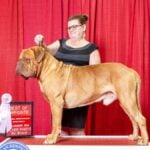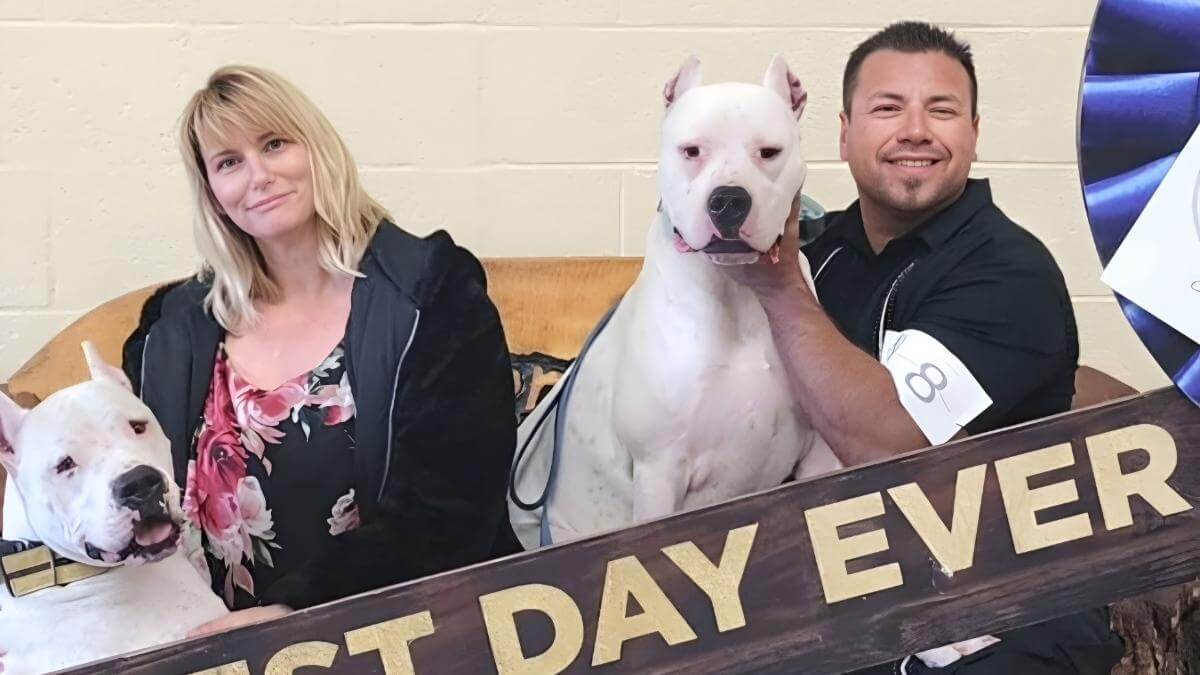


Home » Lynn Felix | Dogos Del Gran Reino Dogos Argentinos

Lynn Felix
1. My name is Lynn Felix. I am a high school English and Psychology teacher. Together with my husband, Erick, who is a fire captain, and our two sons, we run a successful kennel named Dogos Del Gran Reino, which translates to Great Kingdom Dogos in English. We live in Blythe, California. We have owned and bred Dogos Argentinos since 2018. Our love and passion for the breed began years ago when I purchased a Dogo as a gift for my husband for our 20th wedding anniversary. We currently show in the Bred-By class and owner-handle all our Dogos. Several Dogos we’ve produced have earned American Kennel Club (AKC) Champion titles as well as Fast CAT (Coursing Ability Test) Performance sport titles, and their CHIC (Canine Health Information Center) numbers with the OFA (Orthopedic Foundation for Animals). The Dogo Argentino has forever changed our lives.
2. The head of the Dogo is crucial for maintaining breed type because it reflects its purpose, function, and identity. A strong, balanced head with a broad skull, deep muzzle (about equal in length to the skull), and moderate stop shows the power and determination needed for big game hunting. It also helps to distinguish the Dogo from other breeds. If the head is too narrow, too square, or lacking definition, the dog loses the look, strength, and character that define the breed.
Structure ensures the Dogo can perform its function. It needs a muscular, athletic build with a smooth, short, all-white coat; a broad chest; a strong neck; and a balanced frame that allows it to move powerfully and efficiently over long distances. Correct structure supports stamina, agility, and the ability to hold its ground, which are all key traits for a working dog.
Temperament is just as important. The Dogo must be brave, confident, and determined in the field, yet stable, loyal, and trainable around people. A dog that’s too aggressive or too shy would fail in both its working role and family environment. Keeping the right balance of strength and steady temperament preserves the identity of the breed.
3. Most of our planned litters are reserved before we breed. We heavily vet our future puppy homes to make sure they are a good fit for a Dogo. Once someone owns a puppy from us, they become part of our family. We love to hear about all the successes our puppies have with their families as they grow.
4. On the science side, we use advanced health screening tools like PennHIP for hip evaluation, BAER (Brainstem Auditory Evoked Response) testing for hearing, and cardiac evaluations to ensure the long-term health of our lines. Genetic testing via Embark also helps us screen for inherited conditions and verify lineage, allowing for smarter pairings that prioritize health and function.
We have a strong social media presence on both Instagram and Facebook, which makes it easier to stay transparent and connected. We provide educational information and discussions about the breed, show our Dogos in real time, and update our followers on their achievements, upcoming litters, health test results, and more. We also use social media to field inquiries when vetting future homes for our puppies. Additionally, we stay in touch with our puppy families and love sharing updated photos of their Dogos as they grow.
5. People are under the misconception that a Dogo is a couch potato, and they don’t need to do much with it. This could not be further from the truth. The Dogo is highly intelligent and can be stubborn at times. The breed requires both physical and mental stimulation as well as lots of socialization from a young age. If people are not willing to put in the work when the Dogo is young by establishing rules and boundaries and being consistent with them, they may have issues when it matures.
Many people are breeding irresponsibly for size, thinking “bigger is better,” and are producing oversized Dogos. The Dogo has size specifications in the Breed Standard for a reason. Breeding oversized Dogos can negatively affect their overall health, especially their joints, such as hips and elbows, as well as their heart. It also impacts the agility and balance of the Dogo while working in the field.
6. The popularity of the Dogo has increased since its acceptance into AKC in 2020. Irresponsible breeders are out there trying to capitalize on the popularity of the breed and putting the breed at risk for health problems, unstable temperament, and a loss of breed integrity, as many do not do health testing, are not concerned with temperament or function, and lack proper education about the breed. This causes many Dogos to end up in shelters and rescues.
7. When we started showing Dogos back in 2018, there weren’t many of us. But today, those numbers have increased. We now see a lot more people with Dogos in the show ring, as well as many more competing in Performance sports like Fast CAT, Barn Hunt, and Dock Diving. It’s great to see so many people out there representing the breed in such a positive way.